| کد مقاله | کد نشریه | سال انتشار | مقاله انگلیسی | نسخه تمام متن |
|---|---|---|---|---|
| 12809 | 818 | 2005 | 8 صفحه PDF | دانلود رایگان |

Addition of lauric acid to poly (L-lactide) (PLLA) has resulted in a new family of enhanced degradation biomaterials. Presented is PLLA4.5 (PLLA containing 4.5 wt% lauric acid), the fastest degrading of the family. Degradation was studied via mass changes, gel-permeation chromatography, wide- and small-angle X-ray scattering (WAXS and SAXS), simultaneous SAXS and tensile testing, and visual observation. The undegraded PLLA4.5 deformed by crazing, recognisable from the characteristic shape of the SAXS pattern. As water up-take and degradation proceeded, samples crystallised, decreasing the SAXS long period, until by 4 days the deformation mechanism had become that of crystal-mediated deformation. This resulted in a ‘peanut–lemon’-shaped SAXS pattern, interpreted in terms of cavitation and fibrillated shear. Further degradation up to 12 days resulted in the same deformation mechanism at different sample displacements, with samples failing earlier during tensile testing until a ductile–brittle transition occurred. At 30–40 days water up-take and mass-loss increased significantly and global whitening of samples occurred, while the crystallinity and long period stabilised. Complete degradation had not occurred by the end of the study at 73 days. Through an understanding of how the changes in morphology during degradation affect the micromechanisms of deformation, it may be possible to design microstructures to give a tailored evolution of mechanical response in the body.
Journal: Biomaterials - Volume 26, Issue 15, May 2005, Pages 2415–2422